What are grounding exercises?

Photo by PMZ Studio from Pexels
What are Grounding Exercises:? A Path to Mindfulness and Mental Well-Being
In our fast-paced and ever-changing world, it’s easy to get caught up in the whirlwind of stress, anxiety, and overwhelming emotions. Amidst this chaos, grounding exercises offer a lifeline, allowing us to reconnect with the present moment and find inner calm. In this blog post, we will explore the concept of grounding, its importance in maintaining mental well-being, various grounding techniques, real-life benefits, and practical tips for incorporating grounding into our daily lives.
I. The Concept of Grounding
Grounding, also known as earthing or centering, is a mindfulness technique that aims to anchor ourselves in the present moment. It involves directing our attention to our physical sensations, thoughts, and emotions without judgment, which helps to break free from the grip of negative thinking patterns and worries about the past or the future. By grounding ourselves, we can foster a sense of stability and security, making it easier to navigate life’s challenges.
II. Why Grounding is Essential
1. Dealing with Stress and Anxiety: Grounding exercises can act as powerful coping mechanisms in times of stress and anxiety. By refocusing our attention on the here and now, we can reduce the intensity of negative emotions and regain control over our thoughts.
2. Overcoming Past Trauma: For individuals dealing with past traumas, grounding can be instrumental in managing triggers and flashbacks. It helps in grounding the mind in the present reality, diminishing the emotional impact of traumatic memories.
3. Enhancing Focus and Concentration: Grounding techniques have shown to improve concentration and productivity by reducing distractions and mental clutter.
III. Types of Grounding Exercises
1. Physical Grounding Techniques:
a. Deep Breathing: Practicing deep and mindful breathing helps to calm the nervous system and bring awareness to the body’s sensations.
b. Body Scanning: This technique involves slowly scanning your body from head to toe, noticing any tension or discomfort and releasing it through breath and relaxation.
c. Sensory Awareness: Engaging your senses by touching different objects, focusing on smells, or listening to calming sounds can help bring you back to the present moment.
d. Progressive Muscle Relaxation: This exercise involves tensing and then relaxing various muscle groups, promoting a sense of physical and mental relaxation.
2. Mental Grounding Techniques:
a. 5-4-3-2-1 Technique: Acknowledge five things you can see, four things you can touch, three things you can hear, two things you can smell, and one thing you can taste.
b. Visualization: Picture a safe and peaceful place in your mind, such as a beach or a forest, and immerse yourself in the sensory details of that place.
c. Counting and Math-based Techniques: Counting backward or solving simple math problems in your head can help redirect your focus away from stressful thoughts.
d. Affirmations and Positive Self-talk: Repeat positive affirmations to counter negative self-perceptions and cultivate self-compassion.
3. Emotional Grounding Techniques:
a. Emotion Labeling: Acknowledge and label your emotions, which can help you understand and process them more effectively.
b. Emotional Release Exercises: Engage in activities that allow you to express emotions in a healthy way, such as journaling, art, or physical activities.
c. Guided Imagery: Follow guided meditations or imagery exercises to transport yourself to a calm and nurturing mental space.
d. Gratitude Practice: Cultivate gratitude by acknowledging and appreciating the positive aspects of your life.
IV. How to Practice Grounding Exercises
1. Find a Quiet and Comfortable Space: Choose a peaceful environment where you can focus without distractions.
2. Set Aside Time for Regular Practice: Dedicate a few minutes each day to practice grounding exercises to experience their full benefits.
3. Incorporate Grounding into Daily Routines: Use grounding techniques during daily activities, such as showering, eating, or commuting, to stay present and mindful.
V. Real-Life Benefits of Grounding
Grounding exercises have helped numerous individuals improve their mental and emotional well-being. Here are some real-life benefits experienced by practitioners:
1. Personal Anecdotes and Experiences: Stories of individuals who have used grounding techniques to manage stress, anxiety, and emotional challenges.
2. Research-Based Evidence: Studies supporting the effectiveness of grounding exercises in reducing stress, improving mood, and enhancing emotional regulation.
3. Success Stories: Testimonials from individuals who have transformed their lives through grounding practices.
Sure, here is a 4-paragraph article about grounding techniques for anxiety:
Grounding Techniques for Anxiety
Anxiety is a normal human emotion, but it can become overwhelming and debilitating for some people. If you are struggling with anxiety, there are a number of grounding techniques that can help you to calm down and feel more present in the moment.
Grounding techniques are a way of bringing your attention back to the present moment and away from your anxious thoughts. They can help you to feel more grounded and in control, and they can also reduce your physical symptoms of anxiety.
Here are some grounding techniques that you can try:
5-4-3-2-1
This is a simple but effective grounding technique. Start by taking a few deep breaths. Then, focus on your senses and list 5 things you can see, 4 things you can touch, 3 things you can hear, 2 things you can smell, and 1 thing you can taste. This will help you to focus on the present moment and to ground yourself in your surroundings.
Body scan
Another grounding technique is to do a body scan. This involves focusing on your physical sensations and bringing your attention to different parts of your body. Start by focusing on your breath. Then, slowly scan your body from your head to your toes, paying attention to any areas of tension or discomfort. As you scan your body, try to relax any tense muscles.
Grounding object
A grounding object is something that you can hold or touch that helps you to feel grounded. This could be a stone, a piece of jewelry, or a plant. When you are feeling anxious, you can hold or touch your grounding object to help you to focus on the present moment and to feel more calm.
Mindfulness meditation
Mindfulness meditation is a more advanced grounding technique, but it can be very effective for reducing anxiety. Mindfulness meditation involves focusing your attention on the present moment and on your breath. There are many different ways to practice mindfulness meditation, but one simple way is to sit in a comfortable position and focus on your breath for 5-10 minutes.
Grounding techniques can be a helpful way to cope with anxiety. If you are struggling with anxiety, try one or more of these techniques and see if they help you to feel better.
Here are some additional tips for using grounding techniques:
- Practice grounding techniques regularly, even when you are not feeling anxious. This will help you to become more familiar with them and to make them more effective when you need them.
- Find a grounding technique that works for you and that you can easily do. There is no one right grounding technique, so experiment until you find one that you like.
- Be patient. Grounding techniques may not work immediately, but with practice, they can become an effective way to manage anxiety.
If you are struggling with anxiety, it is important to seek professional help. A therapist can teach you additional grounding techniques and help you to develop a plan for managing your anxiety.
VI. Tips for Incorporating Grounding in Daily Life
1. Overcoming Challenges: Addressing common obstacles to practicing grounding exercises and tips to overcome them.
2. Integrating Grounding Techniques: How to apply grounding in various environments, such as work, school, or social settings.
3. Making Grounding a Part of Self-Care: Incorporating grounding into a holistic self-care routine for enhanced well-being.
VII. Additional Resources and Support
1. Books: Recommended reading on mindfulness, grounding, and related topics.
2. Apps: Grounding and meditation apps for easy access to guided exercises.
3. Online Resources: Websites and blogs offering grounding exercises and information.
VIII. Seeking Professional Guidance
If you are dealing with severe anxiety, trauma, or emotional difficulties, consider seeking support from a mental health professional. They can provide personalized guidance and support for your specific needs.
Grounding exercises are valuable tools that can empower us to navigate life’s challenges with greater resilience and inner peace. By anchoring ourselves in the present moment, we can cultivate mindfulness and improve our mental and emotional well-being. Embrace the power of grounding exercises and embark on a journey towards a more centered and fulfilled life.




